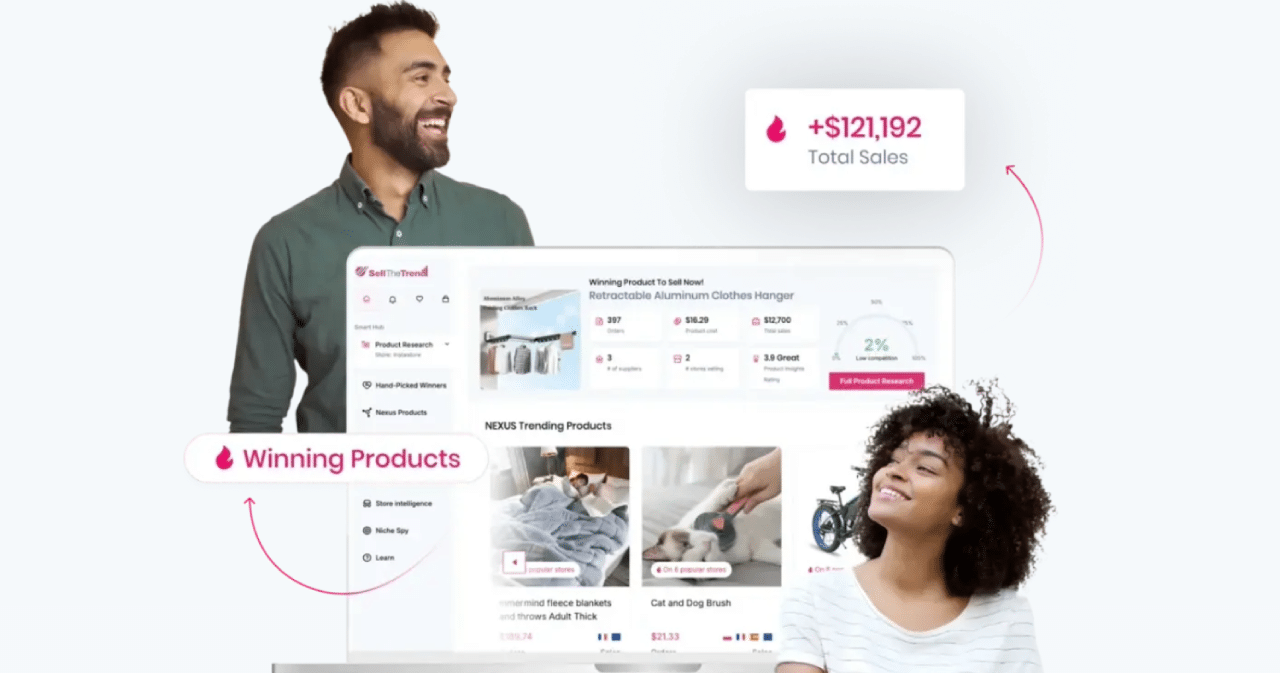How Do You Make Money Dropshipping in 2025
Contents

Dropshipping continues to thrive as a popular business model for aspiring entrepreneurs looking to enter the ecommerce space without heavy upfront investments. So, how do you make money dropshipping?
In 2025, despite increased competition, building a successful dropshipping store remains achievable, especially if you leverage powerful automation platforms like Sell The Trend, which provides advanced AI-driven tools for product research, finding dropshipping suppliers, and managing your online store efficiently.
But with consumer expectations higher than ever, simply setting up a basic dropshipping website and hoping for success won’t suffice. To stand out as a competitive ecommerce retailer, it’s crucial to master effective marketing strategies, carefully choose quality products, and consistently prioritize customers.
Sell The Trend is here to break down exactly how to start dropshipping successfully in 2025, covering everything from sourcing products to ensuring efficient management of your e-commerce business.
Key Takeaways
- Focus on selecting a profitable niche with trending, in-demand products to build a solid foundation for long-term success.
- Partner with reliable suppliers and maintain strong relationships to guarantee consistent product quality and customer trust.
- Optimize your store’s design and user experience to convert visitors into loyal buyers and encourage repeat purchases.
- Leverage automation tools and AI to handle routine tasks efficiently, freeing up time to refine marketing and scale operations.
- Use Sell The Trend to get a competitive edge. Efficient product research, supplier management, and automation.


Straight Answer: How to Make Money With Dropshipping?

In 2025, making money with dropshipping comes down to carefully selecting trending dropshipping products with strong market demand, sourcing from reliable suppliers to guarantee high product quality, and effectively promoting them through targeted social media and other online selling channels. Using an all-in-one platform like Sell The Trend simplifies these crucial tasks by leveraging AI to automate product research, optimize your order fulfillment process, and streamline supplier management, significantly improving your profit margins.
Additionally, successful dropshippers in 2025 proactively conduct competitor research, use data from tools like Google Trends, manage operational costs—including sales tax and fees associated with using a third party supplier—and maintain a smooth-running supply chain to avoid unhappy customers. Combining these elements makes your dropshipping business not just viable, but genuinely profitable.
Strategies for Making Dropshipping Profitable

A straight answer won’t do much for beginners. We need to get into the details.
Here are 8 strategies that you can follow that will maximize the chances of your success.
1. Choosing the Right Niche and Products

Selecting the right niche is foundational to a profitable dropshipping business. The most successful entrepreneurs in 2025 start by carefully identifying trending dropshipping products through detailed market research and tools like Google Trends to pinpoint growing customer interests. By focusing on a well-defined niche, you can more effectively reach your target audience and clearly differentiate your online store from competitors. Always remember: the best niches combine steady demand, appealing profit margins, and manageable competition levels.
Once your niche is set, the next step is sourcing quality products that resonate with your customers. Platforms like Sell The Trend simplify this process dramatically with their AI-powered Product Explorer, which scans millions of products across diverse ecommerce categories. This approach helps you easily identify items likely to generate significant sales volume, allowing you to confidently sell products that meet customer needs and maintain healthy profit margins for your dropshipping store.
2. Finding Reliable Suppliers and Building Relationships

Partnering with dependable dropshipping suppliers is essential for maintaining customer satisfaction and running a profitable ecommerce business. When choosing suppliers, consider critical factors such as their shipping speeds, communication clarity, product quality, and their willingness to sign a transparent dropshipping agreement contract. Working with multiple suppliers is often beneficial as it reduces risk and ensures consistent availability of products.
A powerful platform like Sell The Trend simplifies supplier research by providing instant access to thousands of verified suppliers, each rated by reliability, shipping speed, and quality standards. Establishing strong, long-term relationships with a reliable supplier not only enhances your overall customer experience, but also helps prevent the headaches that arise from dealing with unreliable or inconsistent supply partners. Such relationships directly support the sustainability and profitability of your dropshipping business model.
3. Setting Up a High-Converting Dropshipping Store

Your dropshipping website serves as your primary sales tool, and in 2025 it’s vital that your ecommerce store is optimized for both desktop and mobile customers. High-converting dropshipping stores combine appealing visuals, intuitive navigation, compelling product descriptions, and easy checkout processes. This careful attention to detail helps boost visitor trust and significantly improves conversions.
For those looking to efficiently start dropshipping, using platforms like Sell The Trend is an effective way to quickly launch your store. Their built-in automation allows you to add products to your store with just a single click, automatically creating optimized, high-converting product pages. By ensuring your dropshipping website has a seamless and professional user interface, you not only boost sales but also enhance the overall customer experience, contributing positively to your brand’s reputation and long-term growth.
4. Using AI and Automation for Efficiency

In 2025, the most successful dropshipping companies embrace AI and automation to streamline their operations. Advanced AI-driven platforms, such as Sell The Trend, offer comprehensive solutions to handle repetitive tasks—from identifying trending products and automating the order fulfillment process to managing customer orders and tracking inventory levels with remarkable precision. This technology allows entrepreneurs to run their dropshipping business efficiently, freeing up valuable time to focus on marketing strategies and growth initiatives.
Automation also enhances reliability across your supply chain, reduces human error, and ultimately leads to fewer unhappy customers. The result is improved efficiency, higher customer retention, and consistently strong profit margins.
With Sell The Trend’s AI, managing your dropshipping store becomes significantly less time-consuming and more profitable, giving you an edge over competitors who haven’t adopted these advanced tools.
5. Implementing Effective Marketing Strategies

In 2025, successful dropshipping companies focus on robust and diverse marketing strategies. Leveraging popular emerging channels like social media and social commerce—particularly platforms like TikTok, Instagram, and Facebook—is key. TikTok ads, for example, offer immense potential for rapidly scaling your dropshipping business due to the platform’s high engagement levels. Additionally, influencer partnerships are highly effective, boosting brand credibility and significantly increasing your reach to targeted customer segments.
However, while paid marketing is powerful, prioritizing SEO and content marketing is equally important for long-term organic growth. Regularly publishing relevant, optimized content on your dropshipping website helps drive consistent, targeted traffic without ongoing ad spend.
You can also maximize your profit margins by strategically using email marketing and retargeting campaigns. Email marketing keeps your brand connected with customers, driving repeat purchases and enhancing the overall customer experience, while retargeting converts visitors who initially left your dropshipping store without purchasing, dramatically increasing your conversion rates.
6. Cost Management and Profit Margin Optimization

Effective cost management directly impacts your profit margins and ensures your dropshipping business remains financially healthy. Pricing your products competitively involves:
- Conducting comprehensive competitor research to understand market pricing.
- Accurately calculating costs (including fees paid to dropshipping suppliers, platform fees, advertising expenses, and sales tax obligations).
- Using pricing strategies like psychological pricing or bundled offers to boost sales and maximize profits per transaction.
Carefully managing advertising budgets is critical for profitability. Evaluate Return on Ad Spend (ROAS) regularly and adjust spending accordingly to maintain strong performance. High-performing entrepreneurs consistently track financial metrics to quickly identify overspending and areas for improvement.
Additionally, avoid common pitfalls such as underestimating hidden fees from a third party supplier, neglecting proper calculation of sales tax, or failing to consider the real cost of managing returns from unhappy customers. Maintaining accurate, comprehensive financial records helps your ecommerce business stay profitable and sustainable.
7. Scaling and Growing Your Dropshipping Business

Recognizing the right moment to scale your dropshipping business is crucial. Clear indicators your online store is ready for growth include consistent profitability, efficient handling of increasing customer orders, and reliable performance from your dropshipping suppliers. Once these are aligned, scaling strategies can be effectively implemented, such as:
- Expanding into new selling channels (e.g., Amazon, eBay, Walmart) to diversify income streams.
- Adding complementary products to your existing product lines, carefully vetted through market validation and research.
- Forming a limited liability company (LLC) to protect personal assets, streamline taxes, and enhance the professionalism of your dropshipping business.
Leveraging data analytics is also vital. Using platforms like Sell The Trend can provide actionable insights on which products perform best, customer buying patterns, and opportunities for expansion. With accurate analytics, scaling your dropshipping store becomes a structured, informed process rather than risky guesswork.
8. Staying Competitive and Future-Proofing Your Business

The ecommerce landscape continually evolves, and ensuring your dropshipping business model remains robust in 2025 requires adaptability and foresight. Staying competitive means:
- Regularly performing thorough competitor research to stay informed about market innovations.
- Continuously evaluating and updating your product range according to shifting consumer trends and preferences.
- Keeping your dropshipping website optimized and user-friendly, reflecting modern consumer expectations.
Adapting swiftly to changes such as new regulations affecting ecommerce operations, global disruptions in the supply chain, or shifting market demand helps safeguard your business from unexpected setbacks.
Being proactive—such as regularly reviewing your agreement contract, clearly managing your order fulfillment method, and ensuring consistent product quality—minimizes risk and protects your long-term profitability.
Building a loyal customer base through exceptional service and maintaining a high-quality customer experience ultimately provides your strongest competitive advantage. Loyal customers lead to repeat purchases, positive word-of-mouth marketing, and higher lifetime value, all critical components for sustaining and growing a profitable, future-proof dropshipping business in 2025.
Legal Considerations for Your Dropshipping Business

Navigating the legal landscape is a crucial aspect of running a profitable ecommerce business. While dropshipping is often viewed as a low risk business model compared to other models, failing to address legal essentials can severely impact your profit potential.
Establishing a Limited Liability Company (LLC)
One of the first legal steps you should take when setting up your dropshipping business is forming an LLC. An LLC protects your personal assets by legally separating them from your business liabilities. This structure not only safeguards you against lawsuits but also boosts credibility among your target audience.
Understanding Sales Tax Obligations
Sales tax regulations can vary significantly, especially when you sell products across multiple regions. It’s critical to understand your tax responsibilities clearly to maintain compliance. Platforms like Sell The Trend can integrate with accounting software to simplify tracking your customer orders and managing taxes efficiently, thereby protecting your profit potential from unexpected penalties.
Drafting Agreement Contracts
Having a detailed agreement contract with your dropshipping suppliers helps clearly define responsibilities, shipping expectations, and return policies. Choose from the best dropshipping suppliers that offer transparency and reliability in their agreements, ensuring smooth operations and minimizing potential disputes.
Improving Customer Satisfaction and Support

In an increasingly competitive market, customer opinions is essential to the growth of your dropshipping business. A positive customer experience not only encourages repeat purchases but also enhances your brand’s reputation through favorable reviews on social media and word-of-mouth referrals.
Prioritizing Clear Communication
Promptly addressing customer inquiries on your ecommerce store can set you apart from competitors. Clearly communicate shipping times, order statuses, and any potential delays to avoid frustration. Efficiently handling customer orders and maintaining transparency helps foster trust, essential for sustained growth.
Handling Returns and Complaints Effectively
Dealing with returns or complaints swiftly can transform potentially negative experiences into opportunities for enhanced loyalty. Even if your dropshipping business occasionally faces product quality issues or shipping errors from your suppliers, having clearly defined return policies and fast resolutions significantly boosts customer confidence.
This practice is especially important because dropshipping often operates on low profit margins compared to other business models, making repeat customer relationships vital.
Leveraging Fulfillment Centers for Improved Efficiency
As your business grows, partnering with reputable fulfillment centers can significantly streamline your order processes. This approach ensures products reach your customers quickly and efficiently, reinforcing a positive brand image.
Such efficiency translates directly into enhanced reviews and increased mentions on social media, further amplifying your business’s reach and credibility.
By effectively managing these customer support areas, you strengthen your dropshipping business model, differentiating your brand from competitors and maximizing your overall profitability.
Creating and Building Your Brand

Developing a strong brand is vital to standing out in the crowded ecommerce business space. Branding goes beyond simply having a logo; it’s about crafting a memorable identity that resonates deeply with your target audience and encourages them to repeatedly choose your online store over competitors.
Crafting Your Unique Brand Identity
Your brand identity includes your visual elements, voice, and the overall feeling your ecommerce store conveys. Make sure your branding clearly communicates your values and the unique benefits of the products you offer.
Well-defined branding helps you consistently sell products by building trust and familiarity with customers, ensuring they return time and again.
Leveraging Social Media for Brand Awareness
In 2025, leveraging social media is essential for brand growth. Platforms like Instagram, TikTok, and Pinterest can dramatically increase visibility and engagement.
Regularly posting authentic, valuable content encourages interaction, builds relationships with followers, and ultimately drives your profit potential.
Building Trust and Credibility
Consumers are increasingly cautious about who they buy from online. Boost credibility by transparently communicating shipping and return policies, proactively addressing issues, and openly sharing customer feedback.
This trust-building approach separates your business model from competitors, ensuring long-term customer loyalty.
Managing Risks and Overcoming Common Challenges
Running a profitable dropshipping business isn’t without its hurdles. Understanding potential risks and preparing strategies to overcome common challenges can help safeguard your business’s success, protecting your profit potential from unexpected disruptions.
Addressing Low Profit Margins
One of the main challenges dropshippers face is operating with low profit margins, especially when competing against larger ecommerce businesses.
To counteract this, continuously monitor your pricing strategies, optimize costs by partnering with the best dropshipping suppliers, and focus on products with higher perceived value.
Mitigating Supply Chain Risks
Supply chain disruptions are an inherent risk in dropshipping. Working closely with reliable suppliers who can clearly communicate potential delays is essential.
Diversifying your partnerships with multiple highly-rated dropshipping suppliers can also help reduce risks and ensure smooth operations even if one supplier faces issues.
Dealing with Fluctuating Market Demand
Dropshipping involves rapidly changing market conditions. Protect your dropshipping business from sudden shifts by regularly tracking product performance and consumer trends.
Flexibility in your product selection strategy, aided by platforms like Sell The Trend, allows you to quickly pivot to new products, keeping your online store competitive and profitable.
Effectively managing these challenges turns your dropshipping venture from merely a popular business model into a sustainable, long-term success.
Conclusion
Dropshipping remains an attractive opportunity for entrepreneurs looking to enter the ecommerce space, provided they approach it strategically and proactively.
Success in 2025 will depend on your ability to stay adaptable, continuously refine your strategies, and leverage the best tools and practices available. Prioritizing product quality, reliable partnerships, effective marketing, and outstanding customer service can transform your dropshipping journey from a simple business idea into a sustainable and rewarding venture.
With careful planning and persistence, the potential for building a thriving business through dropshipping is greater than ever. Remember, utilizing Sell The Trend’s powerful AI-driven platform can significantly simplify and enhance every aspect of your dropshipping journey, from product discovery and supplier selection to marketing and automation.
The next step is yours—take action, stay informed, and keep innovating.
FAQ
1. How profitable is dropshipping?
Dropshipping can be very profitable when done correctly, but profitability depends on factors like product selection, pricing strategy, marketing effectiveness, and supplier reliability. Many entrepreneurs earn a healthy income, while others struggle if they don’t treat it as a serious business requiring constant optimization.
2. Is dropshipping a good way to make money?
Yes, it can be a good way to earn money, especially for those looking to start an online business with minimal upfront costs. However, success requires commitment, market research, and ongoing effort to stand out in a competitive market.
3. Can I make $10,000 per month dropshipping?
It’s possible to reach $10,000 per month in revenue or profit, but it usually takes time, testing, and scaling. New store owners should focus first on achieving consistent sales, refining their strategy, and then reinvesting profits to grow toward that goal.
4. Where do most dropshippers fail?
Most fail due to poor product choices, unreliable suppliers, inadequate marketing, and a lack of customer service focus. Many also underestimate the time and effort required to manage operations and build a trustworthy brand.
5. What is the most profitable item to dropship?
There isn’t a single “most profitable” item since trends and demand change constantly. Instead, focus on finding trending, high-demand products within a specific niche that solve a problem or satisfies a strong customer interest. Using data-driven tools can help you discover these opportunities before the market becomes saturated.
6. Can you start dropshipping as a beginner?
Just about anybody can start a dropshipping business, regardless of their level of experience. Of course, it will take you a while to get the hang of it if you are just starting.
7. Is dropshipping better than affiliate marketing?
Dropshipping does have its downsides that can make you consider other alternatives, such as affiliate marketing. However, if you are considering making a switch to affiliate marketing, keep in mind that it is also riddled with its own challenges.
As such, we can’t exactly say that dropshipping is better than affiliate marketing, or otherwise.








